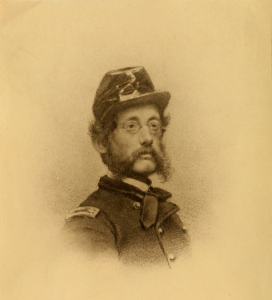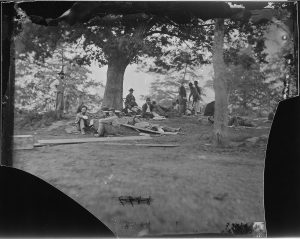“On the Heights”: The Field Hospital at Brompton in May 1864
The wagons rolling into Fredericksburg never seemed to stop. Mary Caldwell, an inhabitant of the town, wrote in her diary, “The road near the fair grounds seems to be literally covered.”[1] They were filled with broken and bloodied bodies, the debris of the dual battles of the Wilderness and Spotsylvania Court House. For almost two weeks, nearly 20,000 wounded soldiers were brought to Fredericksburg for medical treatment and evacuation from the battlefield.

It can be easy sometimes, in the tumult of the Overland Campaign and its never-ending combat and its ever-elongating list of casualties to forget about those left behind each time the armies went to fight somewhere else. The individuals become just numbers: 28,000 casualties at the Wilderness, 30,000 at Spotsylvania. . . To give attention to the wounded, this post will look at the medical care in Fredericksburg, using one hospital as a case study. That hospital was at Brompton, the Marye family home atop the heights that bore their name.
On May 8, the Army of the Potomac’s commander, Maj. Gen. George Meade, issued orders that, “The wounded of the army will be immediately transported to Fredericksburg, and there put in hospital.”[2] By the next morning, a long wagon train dropped off the first 3,000 wounded soldiers who were soon housed in all the nearby “churches, warehouses, and convenient dwelling-houses,” as one surgeon reported.[3] More would come in the days to follow; so many that the Army of the Potomac ordered wagons formerly carrying officers’ personal baggage to be emptied and turned into makeshift ambulances.[4]
As the wounded arrived, the army’s medical personnel tried as best as they could to process them. “Every effort was made to systematize as rapidly as possible,” wrote Surgeon Edward Dalton, overseeing all the field hospitals in the city. Wounded belonging to the same corps were to remain together, and “from the medical officers present of each corps one was selected as surgeon in charge,” Dalton further explained.[5]

Furthermore, not only were the wounded of the same corps supposed to be together, but the army hoped to house soldiers belonging to the same division. This practice did not work perfectly, but nonetheless gives a good indication on where soldiers belonging to the same division ended up in Fredericksburg. The 9th Army, for example, had almost 2,200 wounded soldiers brought to Fredericksburg, and from there, the injured were divvied up by their three divisions.[6]
Brompton’s importance as a hospital comes to the forefront at this point. Sitting atop Marye’s Heights, Brompton was one of the largest buildings available for wounded patients. It had been shot through by musketry and artillery fire during both battles of Fredericksburg, but nonetheless remained sturdy enough for patients. The Marye family had left Fredericksburg, leaving their home abandoned. Soon enough, it was chosen as a hospital for the 2nd Division, 9th Corps. James Noyes, assistant surgeon of the 6th New Hampshire, was put in charge of the medical care there. According to a report filed by the 9th Corps, the hospital “On the Heights” had 500 patients during the army’s stay at Fredericksburg.[7]
To care for the thousands of wounded flooding into Fredericksburg, the army could only spare 50 surgeons, doctors, and attendants, because of the continued combat at Spotsylvania. Outnumbered and overwhelmed, the army’s medical personnel had help on the way. Traveling south from Washington came hundreds of relief workers from organizations like the U.S. Sanitary Commission and the U.S. Christian Commission. They brought many of their own supplies and arrived in Fredericksburg eager to help. Shocked by the sights and sounds of the city, these volunteers nonetheless fanned out and began to help in whichever way they could. William Reed, one of those volunteers, was sent to Brompton, and his writings offer some of the best descriptions of Brompton as a hospital. “Hours prolonged into days, and days into months of suffering,” Reed wrote.[8]
The wounded kept coming until “[n]o available space was left unoccupied,” Reed recalled. “They lay as close as they could be paced, the contaminated air growing worse every hour.” In an ironic twist, the holes blasted open by artillery fire during the battles of Fredericksburg “assisted somewhat in ventilation” and provided fresh air to the patients.[9]
One of the wounded at Brompton was Henry Lancaster, of the 31st Maine Infantry. Shot on May 12 at Spotsylvania, he dictated to his wife, “I am here wounded in the right thigh and there is a chance of my [losing] my leg.” Lancaster had the writer add that he would “write myself but cannot sit up but have to lie on my back all the time.” Getting the letter, Lancaster’s wife Elsada, wrote back “if I could be with you to night to attend to your wants you may hav good cair,” and, she added in the margins, “you will come home.” It was not to be though. Lancaster “died at 12 o’clock midnight Tuesday May 17,” and it fell to William Reed to write Elsada. “I sat down by his side and held his hand & talked with him a long time about you and his dear children,” Reed told her. Before he died, Lancaster gave Reed some papers and a ring, which Reed passed on. Reed finished his letter to the new widow by saying, “The writer of this note belongs for the time to the Sanitary Commission. We do all we can for the noble men who lay down their lives & feel that we cannot do too much for them.”[10] Lancaster was eventually buried in the Fredericksburg National Cemetery.

Besides the written records of the 9th Corps or William Reed, the best available evidence from Brompton’s time as a hospital comes from the images of numerous interested photographers who climbed up Marye’s Heights in late May. They included James Gardner and cameramen working for Mathew Brady. As the rainy days of early May turned to sunshine, the weather was perfect for the photographers to work. It was perfect for the patients, too, and William Reed wrote they moved the wounded “out of the stifling rooms to the lawn.” The photographers found them on the lawns, and soon immortalized them with their cameras.[11]
One of the most famous photographs of the entire war, in fact, was taken during Brompton’s time as a hospital. About a dozen or so patients rest under an oak tree, while doctors and attendants look on. In the center, lying on a stretcher, is a soldier with his foot amputated. Another stares at the camera with bandages wrapped around his amputated arm. It at once humanizes the wounded, and those who sought to care for them.

Though the hospitals were overflowing with patients and the doctors overworked, the Army of the Potomac’s medical triage system ultimately worked. Having been designated as the evacuation point for wounded on May 8, Fredericksburg’s time hosting the wounded lasted just shy of 20 days. The medical personnel at Fredericksburg, though outnumbered, nonetheless proved their skill and determination. Wounded were stabilized and sent north to continue their travels to more permanent hospitals in cities Washington, Baltimore, and Philadelphia. “The removal of the wounded went on with great rapidity,” the army’s medical director wrote, “and by the 27th of May all had been sent off.”[12] Nineteen days; 20,000 wounded, all sent through Fredericksburg. It is a testament to the herculean efforts not just by the army’s personnel, but by the Sanitary and Christian Commission volunteers as well. Brompton was left bloodied and even further torn up by its use as a hospital, but the building remained standing. The oak tree that offered shade on a sunny day still stands too, gnarled by age but still telling its tales.

The field hospital at Brompton showed simultaneously the best and worst in humanity; the holes made by cannon balls and bricks chipped by musketry proved the devastation of war, and those who ran to help in the chaotic days of early May 1864 told of even greater deeds. That wherever there was destruction and bloodshed, there would be those working to put it right.
*Brompton is now property of the University of Mary Washington. It is not open to the public.
____________________________________________________________
[1] “‘It Does Appear as if Our Soldiers Were Made Altogether of Patriotism’: The Civil War Diary of Mary Gray Caldwell, Part 1”, transcribed and edited by Russell P. Smith, Fredericksburg History & Biography, (Vol. 11, 2012,) 79.
[2] Official Records of the Union and Confederate Armies in the War of the Rebellion, Ser. 1, Vol. 36, pt. 2, 527. (Hereafter OR, followed by Vol. and pt. All in Series 1.)
[3] OR, Vol. 36, pt. 1, 234.
[4] Ibid., 227.
[5] Ibid., 270.
[6] Ibid., 236.
[7] Noel G. Harrison, Fredericksburg Civil War Sites: December 1862-April 1865, Volume 2 (Lynchburg: H.E. Howard, 1995), 144; William H. Reed, Hospital Life in the Army of the Potomac (Boston: William V. Spencer, 1866), 21; “List, 1862, of Hospitals in Fredericksburg, by an unknown author,” Virginia Museum of History & Culture (VMHC). Though the title of the document per the VMHC has 1862 in the title, this is an error. “1864” is written at the top of the document itself, and the hospital references are clearly to 1864, not 1862.
[8] Reed, 23.
[9] Reed, 26.
[10] Letters of Henry Lancaster , Elsada Lancaster, and William Howell Reed in Lancaster Family Letters, Maine Historical Society.
[11] Reed, 30; William A. Frassanito, Grant and Lee: The Virginia Campaigns 1864-1865 (New York: Charles Scribner’s Sons, 1983), 71-77.
[12] OR, Vol. 36, pt. 1, 236.
In the last month I saw a video of an NPS guide from Fredericksburg who told the story set forth in the post about medical care @ Brompton. The guide even pointed to a “witness tree”. — it may be the one in the photo above. I recall also that he had a relative who was treated at Brompton. I believe the You Tube or Face Book sponsor was the Museum of Civil War Medicine of Frederick, Md.
A thought provoking article. Most of us arm-chair historians only think about the hard fought battles and not so much about the terrible aftermath.